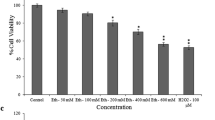Abstract
Most studies on hormonally active agents or endocrine disruptors have been limited to polychlorinated biphenyls and dioxins. In this paper, we report results of in vitro studies on the effects of alkylphenolic compounds, namely, n-pentylphenol, n-hexylphenol, n-heptylphenol, n-octylphenol, and n-nonylphenol, on the injury rate, survival, and acetylcholinesterase activity of the rat pheochromocytoma cell line PC12. Results using the lactate dehydrogenase cytotoxicity assay to determine cell injury rate reveal that the alkylphenols mentioned did not induce cell necrosis beyond 30%, even at concentrations as high as 300 μM in a 15-min incubation period. Exposing the cells to alkylphenols for 4 hr and testing for DNA fragmentation showed that nonylphenol and octylphenol also did not induce apoptosis, even at concentrations as high as 500 and 100 μM, respectively. However, incubating the cells with the alkylphenols for 24 hr significantly inhibited acetylcholinesterase activity at concentrations as low as 0.8 μM, with n-octylphenol showing the most significant effect Since it is believed that human exposure to nonylphenol from drinking water is around 0.7 μg day-1 and that these compounds can accumulate in adipose tissue, this finding may implicate alkylphenols in neurological and behavioral disturbances in both animals and humans.
Similar content being viewed by others
References
Ausubel FM, Brent R, Kingston RE, Moore DD, Seidman JG, Smith JA & Struhl K (eds) (1999) Short Protocols in Molecular Biology.Wiley, New York.
Bragadin M, Perin G, Iero A, Manente S, Rizzoli V & Scutari G (1999) An in vitro study on the toxic effects of nonylphenols (NP) in mitochondria.Chemosphere38(9):1997–2001.
Chao M (1992) Growth factors signaling: Where is the specificity? Cell68:995–997.
Decker T & Lohmann-Matthes M (1988) A quick and simple method for the quantitation of lactate dehydrogenase release in measurements of cellular cytotoxicity and tumor necrosis factor (TNF) activity.J Immunol Methods15:61–69.
Dichter MA, Tischler AS & Greene LA (1977) Nerve growth factor-induced change in electrical excitability and acetylcholine sensitivity of a rat pheochromocytoma cell line.Nature2368: 501–504.
Gray MA, Teather KL & Metcalfe CD (1999) Reproductive success and behavior of Japanese medaka (Oryzias latipes) exposed to 4-tert-octylphenol.Env Toxicol Chem18(11):2587–2594.
Greene LA (1978) Nerve growth factor prevents the death and stimulates the neuronal differentiation of clonal PC12 pheochromocytoma cells in serum-free medium.J Cell Biol78: 747–755.
Greene LA & Tischler AS (1976) Establishment of a noradrenergic clonal cell line of rat pheochromocytoma cells which respond to nerve growth factor.Proc Natl Acad Sci USA73:2424–2428.
Greene LA & Rein G (1977) Release of (3H)-norephinephrine from a clonal line of pheochromocytoma cells (PC12) by nicotinic cholinergic stimulation.Brain Res138:521–528.
Greene LA & Rukenstein A (1981)Regulation of acetylcholinesterase activity by nerve growth factor: Role of transcription and dissociation from effects on proliferation and neurite outgrowth. J Biol Chem256:6363–6367.
Jobling S, Nolan M, Tyler CR, Brighty G & Sumpter JP (1998) Widespread sexual disruption in wild fish.Environ Sci Technol 32:2498–2506.
Jones PA, Baker VA, Irwin AJE & Earl LK (1998) Interpretation of the in vitro proliferation response of MCF-7 cells to potential oestrogens and non-oestrogenic substances.Toxicology in Vitro 12:373–382.
Kim UH, Fink DJ, Kim HS, Park DJ, Contreras ML, Guroff G & Rhee SG (1991) Nerve growth factor stimulates phosphorylation of phospholipase C-γ in PC12 cells.J Biol Chem266:1359–1362.
Klein R, Jing S, Nanduri V, O'Rourke E & Barbacid M (1991) The trk proto-oncogene encodes a receptor for nerve growth factor. Cell 65:189–197.
Korzeniewski C & Callewaert DM (1983) An enzyme-release assay for natural cytotoxicity.J Immunol Methods64:313–320.
Levi-Montalcini R & Angeletti PU (1968) The nerve growth factor. Physiol Rev48:534–569.
Lorenc JF, Lambeth G & Scheffer W (1992) Alkylphenols. In: JI Kioschwitz and M Howe-Grant (eds.), Kirk-Othmer Encyclopedia of Chemical Technology (pp. 113–143).Wiley, New York.
Lucas CA, Czlonkowska A & Kreutzberg GW(1980)Regulation of acetylcholinesterase by nerve growth factor in the pheochromocytoma PC12 cell line.Neuroscience Lett18:333–337.
Lucas CA & Kreutzberg GW (1985) Regulation of acetylcholinesterase secretion from neuronal cell cultures. - 1. Actions of nerve growth factor, cytoskeletal inhibitors and tunicamycin. Neuroscience14:349–360.
Maher P (1988) Nerve growth factor induces protein-tyrosine phosphorylation. Proc Natl Acad Sci USA 85:6788–6791.
Nair-Menon JU, Campbell GT & Blake CA (1996) Toxic effects of octylphenol on cultured rat and murine splenocytes.Toxicol Appl Pharmacol139:437–444.
Raychoudhury SS, Blake CA & Millette CF (1999) Toxic effects of octylphenol on cultured rat spermatogenic cells and sertoli cells. Toxicol Appl Pharmacol157: 192–202.
Rieger F, Shelanski ML & Greene LA (1980) The effects of nerve growth factor on acetylcholinesterase and its multiple forms in cultures of rat PC12 pheochromocytoma cells: Increased total specific activity and appearance of the 16S molecular form.Devl Biol76:238–243.
Schwartzman RA & Cidlowski JA (1993) Apoptosis: The biochemistry and molecular biology of programmed cell death.Endocrine Rev14:133–151.
Schweitzer ES (1993) Regulated and constitutive secretion of distinct molecular forms of acetylcholinesterase from PC12 cells.J Cell Sci106:731–740.
Soltoff SP, Rabin SL, Cantley LC & Kaplan DR (1992) Nerve growth factor promotes the activation of phosphatidylinositol 3-kinase and its association with the trk tyrosine kinase.J Biol Chem267:17472–17477.
Soto AM, Sonnenschein C, Chung KL, Fernandez MF, Olea N & Serrano FO (1995) The E-Screen assay as a tool to identify estrogens: an update on estrogenic environmental pollutants.Environ Health Perspect103(Suppl7):113–122.
Weeks JA, Adams WJ, Guiney PD, Hall JF & Naylor CG (1996) Risk assessment of nonylphenol and its ethoxylates in U.S. river water and sediment.Royal Soc Chem189:276-291.
White R, Jobling S, Hoare SA, Sumpter JP & Parker MG (1994) Environmentally persistent alkylphenolic compounds are estrogenic. Endocrinology 135:175–182.
Author information
Authors and Affiliations
Corresponding author
Rights and permissions
About this article
Cite this article
Talorete, T.P.N., Isoda, H. & Maekawa, T. Alkylphenolic compounds and their effect on the injury rate, survival and acetylcholinesterase activity of the rat neuronal cell line PC12. Cytotechnology 36, 163–169 (2001). https://doi.org/10.1023/A:1014024516821
Issue Date:
DOI: https://doi.org/10.1023/A:1014024516821




